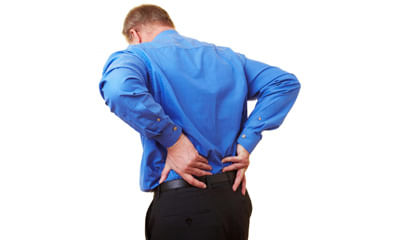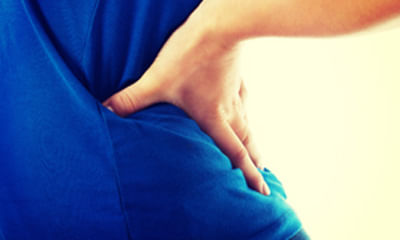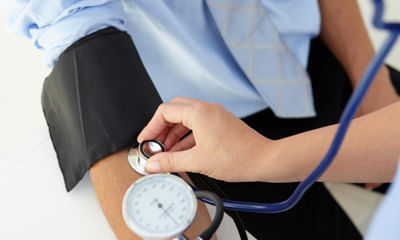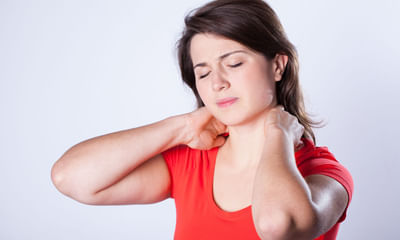Pain Under Right Rib Cage
My mother has a pain in upper back side she has gerd and fatty liver problem a year ago, plss help how to relieve from t ...
Ask Free Question
Upper back pain can occur anywhere between the base of the neck and the bottom of the rib cage. Upper back pain may be caused by injuries or fractures, poor posture, disk problems or other issues, such as arthritis.The common causes of upper back pain stem from inflammation and micro-tears in the muscles, tendons and ligaments of the upper back or from arthritis, herniated disks, vertebral stenosis, or misalignments in the thoracic or cervical spine.A combination of rest, over-the-counter pain medications, and using a heating pad or ice pack can help reduce swelling, relax muscles, and promote healing. You can also visit physiotherapy clinics for drug free treatment option.
Hello, I am having a sharp pain in the left mid side of my back under the rib cage at specific point when deep breathing ...
Ask Free Question
. Standing extension how it helps – this standing extension helps reverse what you do on a daily basis (hunching)… since most bulging discs and herniated discs are caused by poor posture and repeated flexion of the spine (esp bending fwd in bad posture), this stretch helps push the disc back to neutral position. How to do it – begin this exercise by standing up with good posture. Now take both hands and place them on both sides of your lower back. Now with the help of your hands push your pelvis forward and extend your spine back. Follow the extension with your neck so that you end up facing the ceiling. – start with 10 repetitions and do 2-3 sets. – this one is particularly great to do when you need a break from sitting at your desk. ** this should not cause any pain. If you feel pain during it is not a good one for you. In that case, stop and try some of the other exercises below instead. 2. Half cobra pose (prone lumbar extension) how it helps – the half cobra stretch helps to push the disc material back towards the center of the inter-vertebral disc to allow for improved healing. The goal of repeated lower back extension is the “centralization of symptoms”, which basically means pain that travels down the affected leg to the foot should come back up closer to the low back – which will in turn alleviate the pain. How to do it – begin this exercise by lying on your stomach (prone position) and slowly prop yourself up on your elbows while keeping your hips in contact with the floor. – hold the prop-up position for 10-15 seconds before returning to the prone position (lying face down). – gradually increase to holding the end position for 30 seconds. Aim for 10 repetitions of this stretch. ** initially, you may not be able to tolerate this position very well, so make sure you start slowly and carefully. If there’s any pain, try a different exercise instead. 3. Full cobra pose (advanced extension) how it helps – this stretch is based on the same principle as the half cobra pose above. This advanced extension helps to push disc material back towards the center of the intervertebral disc, with the goal of alleviating pain symptoms. How to do it – once you’ve mastered the half cobra pose, you can increase the difficulty by moving to the advanced version of this stretch. Begin this exercise by lying on your stomach in the prone position (lying facing down) and slowly press up on your hands while keeping your pelvis in contact with the floor and lower back relaxed. – hold the prop-up position for 10 seconds. Aim for 10 repetitions of this stretch. – eventually try to hold this pose for longer if it feels good (20-30 seconds). ** if you feel pain during this exercise, it is not a good one for you. In that case, stop and try some of the other exercises instead. 4. Cat-cow how it helps – this is one of the most popular herniated disc exercises. By combining two yoga poses, the cat-cow stretch can help to relieve pressure on the herniated disc by opening the intervertebral disc space. It also improves mobility of the spine, which may help to relieve disc herniation pain and speed recovery. How to do it – begin this stretch on your hands and knees. Inhale and let your stomach “drop” towards the floor as you look up towards the ceiling. – follow this by exhaling and slowly rounding your spine while pressing into the floor with your hands and slightly curving your neck to look at your feet. – aim for 10 repetitions of this stretch and do 2-3 sets. How it helps – this exercise will help strengthen and stabilize your lower back and deep spine muscles. This will help you to maintain a good posture and avoid future episodes of herniated discs. How to do it: – begin on your hands and knees with your hands positioned under your shoulders and knees positioned under your hips. – raise your left arm and reach it forwards until it is aligned with your torso; at the same time, kick your right leg backwards until is it aligned with your torso. – hold this position for 2-3 seconds before slowly returning to the starting position. – repeat with your right arm and left leg. – alternate sides for 10 repetitions and do 2-3 sets. ** ensure that your head, neck, and back maintain a neutral alignment to minimize stress on your neck. 5.plank: how it helps – just like the bird dog, this “core” exercise will help bring your pelvis into right position by strengthening the deep spinal muscles and glutes (butt muscles). How to do it – begin lying on your stomach with your forearms against the mat. – engage your core and lift your body so that you are resting on your forearms and toes. – start with 10 second holds and work up to 30 second holds, do 2-3 sets. ** ensure to keep your back straight throughout the entire exercise – spine in neutral position. Thoracic expansion if you’re using a chair, sit facing forward and allow your upper body to fall over the back of the chair. Extend your arms above your head for a deeper stretch. Hold either position for 10 seconds. 1. Plank the world record for the longest plank is 8 hours. Luckily, you don’t need to hold it that long for the exercise to have an effect! in fact. You can hold it for 10-15 seconds. • the plank is similar to a push-up position, but instead of resting on your hands, you rest on your elbows and bring them directly underneath your chest. • after kneeling, lean forward and place your elbows on the ground directly below your shoulders. • lift your knees off of the floor and push your feet back. Ensure your back is straight and keep your neck aligned with the rest of your spine. • hold the position and tighten your core muscles for the desired time. 2. Side plank just like the original plank, but only balancing on one side. • lie on the floor on your side, facing sideways with your feet together. • lift up your body until you are supporting yourself with your elbow, directly below your shoulder. • raise your hips until your body is in a straight line and tighten your core muscles; your body should create a slant from your shoulders to your feet. • hold this position without dropping your hips. • repeat on the opposite side. 3. Pelvic tilt with exercise ball sit on a ball that allows your legs to be at a 90-degree angle with your feet flat on the floor. • keep your shoulders back and spine straight. • tilt your hips forward and flex your abdominals tight. • tilt your hips backward as you stick your tailbone out. • move back and forth slowly, keeping your shoulders back. • repeat 10 times for 3 sets. 4. Superman lie on your stomach, face down, with your arms out in front of you. • lift arms, legs, and chest off the floor simultaneously while keeping your hips grounded. • hold for a minimum of two seconds. • lower back down slowly. • repeat 10 times for 3 sets. 6. Crunches lie flat on your back, placing your feet flat on the floor with your legs bent. • fold your arms across your chest and lift your torso up until your head, neck, and torso are off the ground. • hold for a moment before lowering back down. • repeat. 6. Quadruped arm opposite leg raises • kneel on the floor, lean forward, and place your hands palm-down on the floor. • make sure your back is straight, your knees are below your hips, and that your palms are directly below your shoulders. • raise one arm as you raise the opposite leg until both are aligned straight out from your body, parallel to your spine. • slowly lower both your arm and leg until you are back in the starting position. • switch arm and leg, and repeat. 7. Dead bug lie flat on the floor on your back. • lift your arms straight up from your body, reaching through the air. • raise one leg until it is at a 90-degree angle from your body. • slowly lower until it is in the starting position. • switch legs and repeat. 8. Hip bridge lie on your back with your knees bent and raised, your feet flat on the floor, and your arms at your sides. • keep your feet hip-distance apart and try to keep your leg in vertical alignment with your knee. • flex your glutes and push through your heels to raise your hips upward. Try to make a diagonal line from your shoulders to your knees. • hold for a short moment before lowering back down. • repeat 10 times for 3 sets.
I have a question please. If someone has rounded shoulders and an anterior pelvic tilt, will it make them shorter, and b ...
Ask Free Question
1.cat-camel on hands and knees, maintain tight abdominals with head straight (photo 1). Take a deep breath in and lift your lower rib cage, round your back and relax your neck (photo 2). As you breathe out, lower your chest towards the floor, looking slightly upward. Return to beginning position with tight abdominals. Repeat ten (10) times per set. Do two (2) sets per session. Do one (1) session per day. •bracing. Bracing may prevent a spinal curve from getting worse, reduce pain, and improve mobility. The right bracing strategy depends on the type of scoliosis a person has, so talk to a doctor before trying a brace. •choosing the right furniture. An ergonomic chair or mattress may better support the spine and back, reducing pain. •massage. Some people find that massage helps with scoliosis pain 2.plank the world record for the longest plank is 8 hours. Luckily, you don’t need to hold it that long for the exercise to have an effect! in fact. You can hold it for 10-15 seconds. •the plank is similar to a push-up position, but instead of resting on your hands, you rest on your elbows and bring them directly underneath your chest. •after kneeling, lean forward and place your elbows on the ground directly below your shoulders. •lift your knees off of the floor and push your feet back. Ensure your back is straight and keep your neck aligned with the rest of your spine. •hold the position and tighten your core muscles for the desired time. 3. Side plank just like the original plank, but only balancing on one side. •lie on the floor on your side, facing sideways with your feet together. •lift up your body until you are supporting yourself with your elbow, directly below your shoulder. •raise your hips until your body is in a straight line and tighten your core muscles; your body should create a slant from your shoulders to your feet. •hold this position without dropping your hips. •repeat on the opposite side. 4. Pelvic tilt with exercise ball sit on a ball that allows your legs to be at a 90-degree angle with your feet flat on the floor. •keep your shoulders back and spine straight. •tilt your hips forward and flex your abdominals tight. •tilt your hips backward as you stick your tailbone out. •move back and forth slowly, keeping your shoulders back. •repeat 10 times for 3 sets. 5. Superman lie on your stomach, face down, with your arms out in front of you. •lift arms, legs, and chest off the floor simultaneously while keeping your hips grounded. •hold for a minimum of two seconds. •lower back down slowly. •repeat 10 times for 3 sets. 6.Crunches lie flat on your back, placing your feet flat on the floor with your legs bent. •fold your arms across your chest and lift your torso up until your head, neck, and torso are off the ground. •hold for a moment before lowering back down. •repeat. 7. Quadruped arm opposite leg raises •kneel on the floor, lean forward, and place your hands palm-down on the floor. •make sure your back is straight, your knees are below your hips, and that your palms are directly below your shoulders. •raise one arm as you raise the opposite leg until both are aligned straight out from your body, parallel to your spine. •slowly lower both your arm and leg until you are back in the starting position. •switch arm and leg, and repeat. 8. Dead bug lie flat on the floor on your back. •lift your arms straight up from your body, reaching through the air. •raise one leg until it is at a 90-degree angle from your body. •slowly lower until it is in the starting position. •switch legs and repeat. 9. Hip bridge lie on your back with your knees bent and raised, your feet flat on the floor, and your arms at your sides. •keep your feet hip-distance apart and try to keep your leg in vertical alignment with your knee. •flex your glutes and push through your heels to raise your hips upward. Try to make a diagonal line from your shoulders to your knees. •hold for a short moment before lowering back down. •repeat 10 times for 3 sets.
I feel painless pressure under my right rib cage for over a year. I had an ultrasound which showed no abnormalities. A c ...
Ask Free Question
Keep ice which will definitely help you to become better. It can also be due to low hemoglobin levels in the body. Anaemia always leads to the symptoms of being tired and also having rib pain. You can lie down with elevated arms in the cot which will help you to get relaxed and also the tidal volume of the lungs will get improved.
Left side pain just under the edge of my ribs. From sternum that wraps around to my side. Doctor has done us of my gallb ...
Ask Free Question
Anaemia always leads to the symptoms of being tired and also having body pain though there may not be any pathological reasons for rib pain. Anaemia always leads to the symptoms of being tired that can also be reason to have frequent strain on the rib cage and sternum. If you have sternum pain that could be due to the gastric problem you can drink lot of hot water in the morning which will help you to become better.
For the last 2 to 3 weeks I have been experiencing pain in my chest, pressure in my rib cages, gas and constipation and ...
Ask Free Question
U have to improve your food habits do 1. Take 2/ 3glass of warm water in the morning before brush 2. Take more water in day 3. Take meals at fixed hrs, chew food properly/ completely, no eating quickly 4. Take small amount of food at a time, take more frequent meals - may be five times a day. 5. No spicy/ fried/ fast/ junk/processed food. Caffeine, 6. No smoking, chewing gum, and carbonated beverages. 6. No milk for few days, can take curd, no uncooked salad 7. Avoid constipation 8. Use nibupani (lemon water) 2/ 3 times a day 9. Do not drink/ store water in plastic bottles. 10 .relax and walk for 30 mts daily 11. Take enough rest- do not lie down immediately after eating. Take dinner 3 hrs before sleeping. No late nights 11. Keep your weight under control. 13. Avoid tea, coffee, alcohol 15. Reduce physical and mental stress. Maintain healthy life style. Do exercise regularly. 16. No unnecessary medicines medicine can not be advised for open question for medicine and further advise contact on private consultation good luck.
My rib cages bones are paining for last few days. Does I take any calcium rich foods. ...
Ask Free Question
U need to find out cause first. Since when r you having this?What r other symptoms that you r experiencing? By doing what like walking, exertion, eating or empty stomach- it increases or decreases in intensity. For how much time it remains? Is there stiffness also? How is your appetite?R you constipated or having loose stools? Any problem in urine?I need details of the case. In the meanwhile follow this1. Take your breakfast every day. Don't skip it. U should eat whatever your mother or grandparent eat in bfast. I mean to say whatever is your traditional food. If punjabi eat paratha, if belongs to south then take idli/ dosa etc. 2. Don't overeat 3. Don't take tea empty stomach. Eat something like a banana (if you are not diabetic) or any seasonal fruit or soaked almonds and a glass of plain water first thing in the morning (preferably within 10 mins of waking up). No only biscuits or rusk will not do. 4. Have light meals every 2 hours (in addition to your breakfast, lunch n dinner) e.g. Nariyal paani, chaach, a handful of mixed dry fruits, a handful of peanuts, any fresh n seasonal fruit (eat whole fruit not juice), a cup of curd/milk etc 5. Take simple food like rice n dal in dinner. Finish your dinner at least 2 hours before going to sleep. 6. Maintain active life style7. Avoid fast foods, spicy n fried foods, carbonated beverages 8. Take a lot of green vegetables n fruit. 9. Drink lot of water.10. Everyday preferably sleep on same time 11. Take 1tsp of ghee in bfast, lunch n dinner. Exercise in the form of yoga, cycling, swimming, gym etc. Or do suryanamaskar daily homeopathy is a very effective for this problem n has very encouraging results. For details, consult online.
Please .what's the cause of the severe pain I have under my right ribs bellow my breast. ...
Ask Free Question
It may be due to liver associated problems follow these herbal combinations sootshekhar ras 1 tablet twice a day pittari avleh 10 gm twice a day get an abdominal ultrasound report.
I'm 22 years from ghana. I always feel movement around my left rib cage anytime I swallow food. Please is it normal? I s ...
Ask Free Question
The chest is a muscle group you might have heard referred to by one catchall name: the pectorals, a.k.a. The pecs. There are actually two muscles that make up your pecs, the pectoralis major and pectoralis minor. The pectoralis major is larger, as the name implies, and is superior (or located above) to the pectoralis minor, is smaller and located below the pec major. The pec major is tasked with adduction of the arm (movement in toward the body) and rotation of the arm forward, along with assisting other muscles in pulling the trunk up when your arms are above your head. The pec minor helps to move your ribs and shoulders. The serratus anterior and subclavius are also chest muscles, which rotate the scapula and anchors and depresses the clavicle, respectively. The benefits of training your chest muscles aesthetics better posture increased strength your chest is a fairly large muscle group, so you'd be hard-pressed to ignore it. Still, the benefits of chest training are important to keep in mind: not only will a well-developed chest have aesthetic benefits in terms of how your shirts fit and how you'll look without one, you'll also see postural benefits (just make sure to balance out your chest day with back training, too). You'll also be stronger anytime you need to push or swing using your arms. 1.Stand tall with your feet together. 2.Hold the end of a towel or exercise band in each hand, with your arms behind your body. 3.Use the towel or band to help move your shoulder blades together and open your chest. This will cause you to look toward the ceiling. 4.Hold this pose for up to 30 seconds. 5.Repeat 3–5 times.
I am a 13 year old female with weak bones (scoliosis). I was sitting on my foot and when I got up, my toe was hanging do ...
Ask Free Question
Scoliosis is a sideways curvature of the spine that most often is diagnosed in adolescents. While scoliosis can occur in people with conditions such as cerebral palsy and muscular dystrophy, the cause of most childhood scoliosis is unknown. Most cases of scoliosis are mild, but some curves worsen as children grow. Severe scoliosis can be disabling. An especially severe spinal curve can reduce the amount of space within the chest, making it difficult for the lungs to function properly. The angle of the curve may be small, large, or somewhere in between. But anything that measures more than 10 degrees on an x-ray is considered scoliosis. Children who have mild scoliosis are monitored closely, usually with x-rays, to see if the curve is getting worse. In many cases, no treatment is necessary. Some children will need to wear a brace to stop the curve from worsening. Others may need surgery to straighten severe curves. Signs and symptoms of scoliosis may include: uneven shoulders one shoulder blade that appears more prominent than the other uneven waist one hip higher than the other one side of the rib cage jutting forward a prominence on one side of the back when bending forward complications breathing problems-in severe scoliosis, the rib cage may press against the lungs, making it more difficult to breathe. Back stiffness pain and numbness in your legs (from pinched nerves) fatigue due to muscle strain appearance-noticeable changes — including uneven hips and shoulders, prominent ribs, and a shift of the waist and trunk to the side. Individuals with scoliosis often become self-conscious about their appearance. Full-time braces:•milwaukee brace. •boston brace. •wilmington brace. Nighttime braces: •charleston bending brace. Treatment braces- if your child's bones are still growing and he or she has moderate scoliosis, your doctor may recommend a brace. Wearing a brace won't cure scoliosis or reverse the curve, but it usually prevents the curve from getting worse. The most common type of brace is made of plastic and is contoured to conform to the body. This brace is almost invisible under the clothes, as it fits under the arms and around the rib cage, lower back and hips. Most braces are worn between 13 and 16 hours a day. A brace's effectiveness increases with the number of hours a day it's worn. Children who wear braces can usually participate in most activities and have few restrictions. Exercises benefits of scoliosis exercises •reduce spinal curvature. •improve brain and muscle coordination. •slow down or stop scoliosis progression. •stabilize and reduce existing curvature. •reduce the need for surgery or invasive bracing. Slowly move your neck, arms, and mid-torso in the opposite direction. Hold this pose for 5 seconds and then slowly return to the starting position. Do this on the opposite side too. Repeat this 10 times. Hold the pose for 2 seconds. Precaution do not twist too much or for too long. Exercises to avoid •exercises that require you to lean or bend forward. •exercises that require you to overextend or curve your lower back. •football or competitive swimming. •sleeping on your belly. •playing or jumping on the trampoline. •running for long distances. •lifting or carrying heavy objects. •heavy weightlifting at the gym. Flat foot that might trigger the pain always and however we treat that may not help. Hot water fermentation will help and that can be done by immersing the foot in hot water. Wear mcr chappals.







